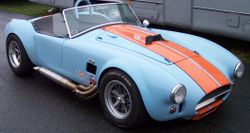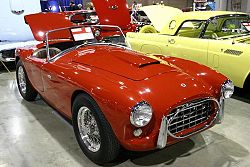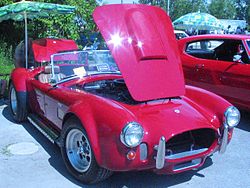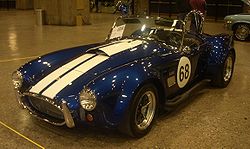- AC Cobra
-
"Shelby Cobra" redirects here. For the 2004 Ford Shelby Cobra Concept, see Ford Shelby Cobra Concept.
AC Cobra 
Manufacturer AC Cars Also called Shelby Cobra Production 1961–1967 Assembly Thames Ditton, Surrey, England Body style 2-door roadster Layout FR layout MkI 
Production 1962–1963 Engine 260 cu in (4.3 L) V8 Wheelbase 90 in (2,286 mm) Length 151.5 in (3,848 mm) Width 61 in (1,549 mm) Height 49 in (1,245 mm) Curb weight 2,019 lb (916 kg)[1] MkII Production 1963–1965 Engine 289 cu in (4.7 L) V8 Wheelbase 90 in (2,286 mm) Length 151.5 in (3,848 mm) Width 61 in (1,549 mm) Height 49 in (1,245 mm) Curb weight 2,315 lb (1,050 kg)[2] MkIII 
Production 1965–1967 Engine 427 cu in (7.0 L) V8 Wheelbase 90 in (2,286 mm) Length 156 in (3,962 mm) Width 68 in (1,727 mm) Height 49 in (1,245 mm) Curb weight 2,355 lb (1,068 kg)[3] The AC Cobra, also known colloquially as the Shelby Cobra in North America, is an Anglo-American sports car that was produced during the 1960s.
Contents
History and development
Like many British specialist manufacturers, AC Cars had been using the smooth, refined Bristol straight-6 engine in its small-volume production, including its AC Ace 2-seater roadster. This had a hand-built body with a steel tube frame, and aluminium body panels that were made using English wheeling machines. The engine was a pre-World War II design of BMW which by the 1960s was considered dated. Bristol decided in 1961 to cease production of its engine and instead to use Chrysler 331 cid (5.4 L) V8 engines. Although untrue, it is commonly believed that AC was left without a future source of power and that American ex-racing driver Carroll Shelby saved the company from bankruptcy. AC started using the 2.6 litre Ford Zephyr engine in its cars. In September 1961, Shelby airmailed AC a letter asking them if they would build him a car modified to accept a V8 engine. AC agreed, provided a suitable engine could be found. He first went to Chevrolet to see if they would provide him with engines, but not wanting to add competition to the Corvette they said no. Ford however, wanted a car that could compete with the Corvette and they happened to have a brand new thin-wall small-block engine which could be used in this endeavor. It was Ford's 260 in³ HiPo (4.2 L) engine – a new lightweight, thin-wall cast small-block V8 tuned for high performance. Ford provided Shelby with two 260ci engines. In January 1962 mechanics at AC Cars in Thames Ditton, Surrey fitted the prototype chassis CSX0001 with a 260ci Ford V8; the 221ci was never sent. However, early engineering drawings were titled "AC Ace 3.6". After testing and modification, the engine and transmission were removed and the chassis was air-freighted to Shelby in Los Angeles on 2 February 1962.[4] His team fitted it with an engine and transmission in less than eight hours at Dean Moon's shop in Santa Fe Springs, California, and began road-testing.
Chassis numbering:
AC's system was as follows: The Ace chassis numbers read AEX... "A" being the car series and "X" being for export with left hand drive. Later with the introduction of the Bristol engine the chassis numbers ran "BEX..." When switching to the Ford 2.6 engine the Ace chassis numbers ran "RS..." for Ruddspeed as Ken Rudd may have been influential in the choice of engine. The first Cobra chassis was left hand drive and given the next letter in the alphabet,i.e. C. Therefore the numbers ran CSX2... for all the export Cobras. Otherwise, the prefix was "CS2...". The four following numbers ran from 2000 sequentially. When the MKIII Cobra was built the identification ran from CSX3000 (for left hand drive export). There were other numbers used such as "COB...." and "COX...".
Production proved to be easy, since AC had already made most of the modifications needed for the small-block V8 when they installed the 2.6 litre Ford Zephyr engine, including the extensive rework of the AC Ace's front end. The most important modification was the fitting of a stronger rear differential to handle the increased engine power. A Salisbury 4HU unit with inboard disk brakes to reduce unsprung weight was chosen instead of the old ENV unit. It was the same unit used on the Jaguar E-Type. On the production version, the inboard brakes were moved outboard to reduce cost. The only modification of the front end of the first Cobra from that of the AC Ace 2.6 was the steering box, which had to be moved outward to clear the wider V8 motor.
The first 75 Cobra Mark I (including the prototype) were fitted with the 260 engine (4.2 L). The remaining 51 Mark I model were fitted with a larger version of the Windsor Ford engine, the 289 in³ (4.7 L) V8. In late 1962 Alan Turner, AC's chief engineer completed a major design change of the car's front end and was able to fit it with rack and pinion steering while still using transverse leaf spring suspension. The new car entered production in early 1963 and was designated Mark II. The steering rack was borrowed from the MGB while the new steering column came from the VW Beetle. About 528 Mark II Cobras were produced to the summer of 1965 (the last US-bound Mark II was produced in November 1964).
Since late '62 when the new GM Stingray was shown up briefly by the Mk1 Cobra (until hub failure intervened) the development of the Grand Sport Corvette program had continued at a pace and was thought to be going for a build series of 125 cars. This would allow GM to compete directly in the FIA GT class of racing. Just to compound this Enzo Ferrari was trying to pull another "fast one" on the FIA with the request for the homologation of the 250LM. The FIA had not forgotten the serious lack of production of the 250GTO, which it had granted homologation in advance of Enzo's assured 100 minimum per year... Just thirty six were produced over three years with two very different chassis. Neither of which were too similar to the 250 GT which was supposed to form the basis of the vehicle. In an effort to prepare for the task ahead alternative engines were considered. Whilst the 289CID leaf-spring Cobra was totally dominant is the US domestic race series (USRRC), with only one race lost in three years of racing, the situation in the FIA GT class was different. This was mainly due to the number of circuits which allowed for much higher sustained speeds. Here aerodynamics took a greater hand and put the roadster at a disadvantage. This was offset by no less than AC, Shelby and the Willment team building their coupes (see below).
However, with the inclusion of the Grand Sport Corvette this would likely change that dominance. A stroker 289 (325), 351 and the larger 390/427 up to the "cammer" 427 was considered. Then major big business politics came into play and no decision was reached within Ford for too long. Shelby was told at the eleventh hour to use the iron 427cid. This had the knock on effect that there was simply no time to "productionise" a vehicle which was all that it was hoped for in terms of competition. The coil spring Cobra started to roll slowly of the line but it was clear that there was not going to be sufficient produced to satisfy the FIA's granting of the GT homologation. Therefore the S/C (street / competition) was produced by making available to the general production the full race options for the street! By now Enzo was having races recatergorised in Italy to prevent the almost inevitable defeat on home soil as the 250LM was not homologated as a GT and would have to run as a prototype. GM had pulled the plug on the Grand Sport and so the five chassis that were built had to run as prototypes and so were placed in a difficult position to say the least.
Shelby had earlier in '64 fit a larger Ford FE engine of 390 cubic inches (6.4 L) in to CSX2196. Unfortunately the car was not able to receive the development it needed as resources were aimed at taking the crown from Ferrari in the GT class. Ken Miles drove and raced the FE-powered Mark II at Sebring and pronounced the car was virtually undrivable, naming it "The Turd" It failed to finish with the engine expiring due to damper failure. A new chassis was required developed and designated Mark III. CSX2196 was revised for the show down at Nassau which allowed a more relaxed class division of racing. This allowed the GT cobras to run with prototype Ford GT, GM Grand Sport Corvettes and Lola Mk6. The first meeting that the GS Corvettes turned up to in '63 it was clear that they were going to be difficult for the Cobras to beat with out development / evolution. It was for this event in '64 that the Fliptop cobra was used. The aluminium 390cid engine was used from the Sebring outing. After the first lap this rocket had pulled out a lead of almost the length of the start finish straight on the GS Corvettes ! It was not to last though as the car failed to finish.
The new car was designed in cooperation with Ford in Detroit. A new chassis was built using 4 in (102 mm) main chassis tubes (up from 3 in (76 mm)) and coil spring suspension all around. The new car also had wide fenders and a larger radiator opening. It was powered by the "side oiler" Ford 427 engine (7.0 L) rated at 425 bhp (317 kW), which provided a top speed of 164 mph (262 km/h) in the standard model and 485 bhp (362 kW) with a top speed of 185 mph (298 km/h) in the competition model. Cobra Mark III production began on the 1st of January 1965; two prototypes had been sent to the United States in October 1964. Cars were sent to the US as unpainted rolling chassis, and they were finished in Shelby's workshop. Although an impressive automobile, the car was a financial failure and did not sell well. In fact to save cost, most AC Cobra 427s were actually fitted with Ford's 428 cubic inches (7.01 L) engine, a long stroke, smaller bore, lower cost engine, intended for road use rather than racing. It seems that a total of 300 Mark III cars were sent to Shelby in the USA during the years 1965 and 1966, including the competition version. 27 small block narrow fender versions, which were referred to as the AC 289, were sold in Europe. Unfortunately, The MK III missed homologation for the 1965 racing season and was not raced by the Shelby team. However, it was raced successfully by many privateers and went on to win races all the way into the 70s. The remaining 31 unsold examples were detuned and fitted with wind screens for street use. Called S/C for semi-competition, an original example can currently sell for 1.5 million USD, making it one of the most valuable Cobra variants.[5]
AC Cobras had an extensive racing career. Shelby wanted it to be a "Corvette-Beater" and at nearly 500 lb (227 kg) less than the Chevrolet Corvette, the lightweight car did just that. It was February 2, 1963 at Riverside International Raceway that driver Dave MacDonald beat an impressive field of Corvettes, Jaguars, Porsches, and Maseratis to give the Cobra its first-ever victory. Later, Shelby offered a drag package, known as the Dragonsnake, which won several NHRA National events with Bruce Larson or Ed Hedrick at the wheel of CSX2093.[5]
The Cobra was perhaps too successful as a performance car and reputedly contributed to the implementation of national speed limits in the United Kingdom. An AC Cobra Coupe was calculated to have done 186 mph (299 km/h) on the M1 motorway in 1964, driven by Jack Sears and Peter Bolton during shakedown tests prior to that year's Le Mans 24h race.[6] However, government officials have cited the increasing accident death rate in the early 1960s as the principal motivation, with the exploits of the AC Cars team merely highlighting the risk.
Although successful in racing, the AC Cobra was a financial failure, which led Ford and Carroll Shelby to discontinue importing cars from England in 1967. AC Cars kept producing the coil spring AC Roadster with narrow fenders, a small block Ford 289 and called the car the AC 289. It was built and sold in Europe until late 1969. AC also produced the AC 428 until 1973. The AC Frua was built on a stretched Cobra 427 MK III coil spring chassis using a very angular handsome steel body designed and built by Pietro Frua. With the demise of the 428 and succeeding 3000ME, AC shut their doors in 1984 and sold the AC name to a Scottish company. The company's tooling, and eventually the right to use the name, were licensed by Autokraft, a Cobra parts reseller and replica car manufacturer owned by Brian A. Angliss.
Autokraft era
Autokraft manufactured an AC 289 continuation car from 1982 as the Autokraft Mk IV, basically a Mk III with a 5.0 L (302 cu in) Ford V8 and Borg Warner T5 Transmission. The Mk IV also received an independent suspension. Shortly thereafter, Carroll Shelby filed suit against AC Cars and Brian A. Angliss, in U.S. District Court in Los Angeles. The ensuing settlement resulted in Shelby and AC Cars/Angliss releasing a joint press release whereby AC/Angliss acknowledged that Carroll Shelby was (and is) the manufacturer of record of all the 1960s AC Cobra automobiles in the United States and that Shelby himself is the sole person allowed to call his car a Cobra. Nonetheless, production of the Mk IV continued, from 1987 as a joint venture with Ford as the AC Mk IV with a 250 hp (186 kW) at 4,200 rpm, 4,942 cc Ford V8 which provided a top speed of 215 km/h (134 mph) and 0–100 km/h in 5.2 seconds. At the 1990 Geneva Salon the Lightweight version was presented: weight was down to 1,070 kg (2,400 lb) (compared to 1,190 kg or 2,600 lb) and power was up to 370 hp (276 kW) at 5,750 rpm thanks to alloy heads, a Holley Performance Products four-barrel carburettor, and no catalytic converter.[7] While the Lightweight did not meet US federal regulations, the Mk IV did, and 480 cars of all versions were built until 1996.
Post Autokraft era
Brian Angliss left AC Cars in 1996 and the company was restructured under new management. Two new 'Cobra' style cars were launched in 1997, the 'Superblower', an aluminium bodied car with a supercharged 4,942cc Ford V8 providing 320bhp and the cheaper 'Carbon Road Series' (CRS) with a carbonfibre body and a 225bhp version of the Ford V8 engine. 22 Superblowers and 37 CRSs were built between 1997 and 2001.
A further variant, 'the 212 S/C' with a 3506cc 350hp twin-turbocharged Lotus V8 engine was introduced in 2000, but only 2 examples were built.
In 2006, AC closed its UK factory and moved to Malta. However only 3 right-hand drive carbon-fibre AC Mk Vs powered by 340bhp 5 litre Ford V8 engines were built before the Maltese operation closed. Since 2009, AC has licenced Gullwing GmbH in Germany to produce the AC MK VI, with an aluminium coated composite body and powered by a 6.2 litre 440hp LS3 Chevrolet engine, or a 550hp supercharged version. In the UK, AC Heritage based at Brooklands, is licenced by AC to produce traditional 289 and 427 continuation ACs.
Coupé
1964 Shelby Daytona Cobra Coupe (CSX2299)
In an effort to improve top speed along the legendary Mulsanne Straight at the 24 Hours of Le Mans race, a number of enclosed, coupe variations were constructed using the leafspring chassis and running gear of the AC/Shelby Cobra Mark II. The most famous and numerous of these were the official works Shelby Daytona Cobra Coupes. Six were constructed in total, each being subtly different from the rest. AC Cars Ltd also produced a Le Mans coupé. The car was a one-off and was nearly destroyed after a high-speed tire blow-out at the 1964 Le Mans race. The car was qualified conservatively second in GT. The race started well with the AC, chassis number A98, maintaining its position in the top two in GT and even leading the class for a time. This was not to last as an act of sabotage (newspaper in the fuel tank) began to block the fuel filter. The car lost time until this was diagnosed and cleaned out. The car proceeded on at the predetermined conservative lap time and for the next stint remained trouble free. If this pace had been maintained then the car would have finished at least 4th overall! The car was completely rebuilt and as of now is in private ownership in Scotland. It is interesting to note that the car was able to match the Shelby Daytona's speed despite running a higher differential ratio (2.88 instead of 3.07) and a lower state of engine tune for reliability (355hp instead of the Daytona's 385hp). The only way for this to be so is that the AC's (A98) aerodynamics are superior.
The third significant Cobra-based coupe was the Willment Cobra Coupe built by the JWA racing team.
A road-going Shelby Daytona Cobra replica is being manufactured by Superformance and Factory Five Racing, a well known kit car company. These cars use Pete Brock's bodywork designs, scaled up to increase room inside, and a newly designed spaceframe chassis, they are powered by Roush-built Ford Windsor (Sportsman) engines. The Superformance Shelby Daytona Coupe is the only modern-day vehicle recognized by Shelby as a successor to the original Coupes.
Continuation cars
From the late 1980s onwards, Carroll Shelby (Shelby Automobiles, Inc.) and associated companies have built what are known in the hobby as "Continuation Cars"; Shelby authorized continuations of the original AC-bodied Shelby Cobra series. Produced in Las Vegas, Nevada, these cars retain the general style and appearance of their original 1960s ancestors, but are fitted with modern amenities. Initially the car everyone wanted in a Continuation was a 427 S/C model which was represented in the CSX4000 series. This was meant to continue where the last 427 S/C production left off, at approximately serial number CSX3560 in the 1960s.
The initial CSX4000 series cars were completed from some supposedly left over 1960's chassis new old stock as well as newly manufactured parts. However, all chassis that left AC's are accounted for in their records and there was not a batch left over. Given the value of the vehicle many "extra" cars have appeared over the years, even some sharing the same chassis number. Gradually as the vintage parts supply ran low, newly constructed frames and body panels were obtained from a variety of suppliers. The production of chassis numbers CSX4001 to CSX4999 took roughly 20 years and many different business relationships to complete.
All models of Cobra produced are available now as continuations. In 2009, CSX4999 was produced, concluding the 4000 series. Production has continued with the CSX6000 serial numbers, featuring "coil over" suspension. The 289 FIA "leaf spring" race version of the car is reproduced as CSX7000, and the original "slab side" leaf spring street car is the CSX8000 series.
To date most continuations are produced in fiberglass, with some ordering cars with aluminum or carbon fibre bodywork.
In 2004, at the North American International Auto Show in Detroit, Ford unveiled a concept for a modernized Shelby Cobra. The Ford Shelby Cobra Concept was a continuation of Ford's effort to bring back the retro sports cars that had been successful in the 1960s, including the Ford GT40 and the fifth generation Ford Mustang.
Continuation cars were also produced by AC Cars up until 2006, and since 2009 have been produced by AC Heritage who are licensed by AC to produce 289 and 427 continuations.
Super Snake
Shelby Motors built twenty two 427 competition roadsters. In 1965, one was selected and converted into a special model called the 427 "Cobra to End All Cobras." The first one of these (number CSX3015) was originally part of a European promotional tour before its conversion. This conversion called for making the original racing model street legal with mufflers, a windshield and bumpers amongst other modifications. But some things were not modified, including the racing rear end, brakes and headers. The most notable modification is the addition of Twin Paxton Superchargers. This gave the car a claimed 800 brake horsepower (600 kW) and 800 lb·ft (1,085 N·m) of torque at 3000 rpm. Officially 0–60 mph (0–97 km/h) was achieved in 4.5 seconds.[citation needed]
Another non-competition 427 roadster, CSX3303, was converted and given to Shelby's close friend, Bill Cosby. Cosby attempted to drive the super-fast Cobra, but had issues with keeping it under control. This was humorously documented in Cosby's album titled Bill Cosby, 200 M.P.H.. Cosby gave the car back to Shelby, who then shipped it out to one of their dealers in San Francisco, S&C Ford on Van Ness Avenue. S&C Ford then sold it to customer Tony Maxey. Maxey, suffering the same issues as Cosby did with the car, lost control and drove it off a cliff, landing in the Pacific Ocean waters.[8]
Shelby's original model, CSX3015, was kept by Carroll Shelby himself over the years as a personal car, sometimes entering it into local races like the Turismos Visitadores Cannonball-Run race in Nevada, where he was "waking [up] whole towns, blowing out windows, throwing belts and catching fire a couple of times, but finishing."[9] The CSX3015 was auctioned on 22 January 2007, at the Barrett-Jackson Collector Car Event in Scottsdale, Arizona, for $5 million plus commission (£2.8 million).[10][11]
See also
- The Snake and the Stallion
Notes
- ^ "1962 AC Cobra 260 car technical specifications from Carfolio.com – 2 door 4.2 litre (4265 cc) V8 263.6 PS, 4 speed manual". Carfolio.com. 2008-08-22. http://www.carfolio.com/specifications/models/car/?car=51997. Retrieved 2011-02-02.
- ^ "1963 AC Cobra 289 car technical specifications from Carfolio.com – 2 door 4.7 litre (4727 cc) V8 274.8 PS, 4 speed manual". Carfolio.com. 2008-08-22. http://www.carfolio.com/specifications/models/car/?car=51964. Retrieved 2011-02-02.
- ^ "1968 Shelby Cobra 427 car technical specifications from Carfolio.com – 2 door 7 litre (7010 cc) V8 359.9 PS, 4 speed manual". Carfolio.com. http://www.carfolio.com/specifications/models/car/?car=4950. Retrieved 2011-02-02.
- ^ Friedman, Dave: "Shelby Cobra: the Shelby American color archives", chapter 1, MBI Publishing Company, ISBN 0-87938-757-2
- ^ a b "1966 Shelby Cobra 427 S/C". Supercars.net. http://www.supercars.net/cars/5175.html. Retrieved 2011-02-01.
- ^ "185mph on the British motorway in 1963 – the real story from Jack Sears". classicdriver.com. http://www.classicdriver.com/uk/magazine/3200.asp?id=11841. Retrieved 2008-01-04.
- ^ Büschi, Hans U., ed (March 1991) (in German/French). Automobil Revue 1991. 86. Berne, Switzerland: Hallwag AG. p. 151. ISBN 3-444-00514-8.
- ^ "Barrett-Jackson Lot: 1301 – 1966 Shelby Cobra 427 "Super Snake"". barrett-jackson.com. http://www.barrett-jackson.com/application/onlinesubmission/lotdetails.aspx?aid=221&ln=1301&pop=0&it=1. Retrieved 1 May 2011.
- ^ "Barrett-Jackson Classic Car Show and Auction – 1966 Shelby Cobra 427 Supersnake". about.com. http://gosw.about.com/od/festivalsandevents/ss/shelbycobra_3.htm.
- ^ "Carroll Shelby's Super Snake Sells For Record $5 Million Dollars". mustangblog.com. http://www.mustangblog.com/blog/1017267_carroll-shelbys-super-snake-sells-for-record-5-million-dollars.
- ^ "Car goes for £2.8million". thesun.co.uk (London). 10 May 2007. http://www.thesun.co.uk/sol/homepage/news/article29515.ece. Retrieved 2008-01-04.
External links
Categories:- 1960s automobiles
- AC vehicles
- Rear wheel drive vehicles
- Shelby vehicles
- Roadsters
- Sports cars
Wikimedia Foundation. 2010.




